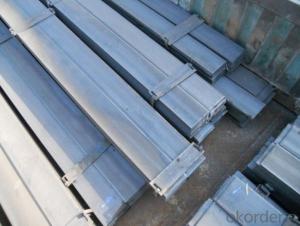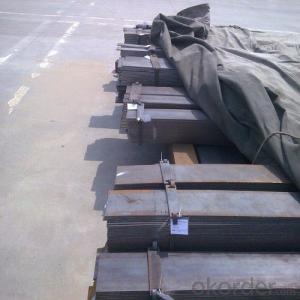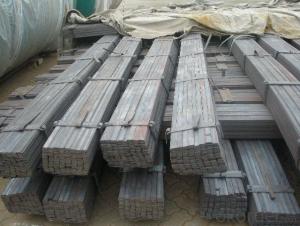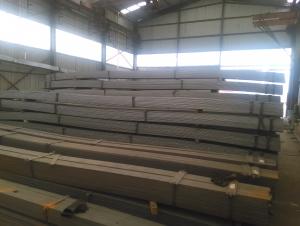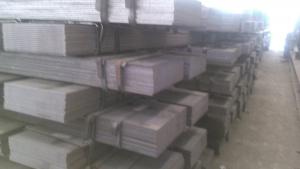Hot Rolled Flat Bars in Grade Q235B with Good price
- Loading Port:
- Tianjin
- Payment Terms:
- TT OR LC
- Min Order Qty:
- 25 m.t.
- Supply Capability:
- 10000 m.t./month
OKorder Service Pledge
OKorder Financial Service
You Might Also Like
Product Description:
OKorder is offering high quality Hot Rolled Steel Flat bars at great prices with worldwide shipping. Our supplier is a world-class manufacturer of steel, with our products utilized the world over. OKorder annually supplies products to European, North American and Asian markets. We provide quotations within 24 hours of receiving an inquiry and guarantee competitive prices.
Product Applications:
Hot Rolled Steel Flat bars are ideal for structural applications and are widely used in the construction of buildings and bridges, and the manufacturing, petrochemical, and transportation industries.
Product Advantages:
OKorder's Steel Flat bars are durable, strong, and resist corrosion.
Main Product Features:
· Premium quality
· Prompt delivery & seaworthy packing (30 days after receiving deposit)
· Corrosion resistance
· Can be recycled and reused
· Mill test certification
· Professional Service
· Competitive pricing
Product Specifications:
Manufacture: Hot rolled
Grade: Q195 – 235
Certificates: ISO, SGS, BV, CIQ
Length: 6m – 12m, as per customer request
Packaging: Export packing, nude packing, bundled
Chemical composition of Q235
Alloy No | Grade | Element(%) | ||||
C | Mn | S | P | Si | ||
Q235 | B | 0.12—0.20 | 0.3—0.7 | ≤0.045 | ≤0.045 | ≤0.3 |
Physical properties of Q235
Alloy No | Grade | Yielding strength point(Mpa) | Tensile strength (Mpa) | Elongation after fracture(%) | ||||||
Thickness (mm) | Thickness (mm) | |||||||||
≤16 | >16--40 | >40--60 | >60--100 | ≤16 | >16--40 | >40--60 | >60--100 | |||
≥ | ≥ | |||||||||
Q235 | B | 235 | 225 | 215 | 205 | 375--500 | 26 | 25 | 24 | 23 |
FAQ:
Q1: Why buy Materials & Equipment from OKorder.com?
A1: All products offered by OKorder.com are carefully selected from China's most reliable manufacturing enterprises. Through its ISO certifications, OKorder.com adheres to the highest standards and a commitment to supply chain safety and customer satisfaction.
Q2: How do we guarantee the quality of our products?
A2: We have established an advanced quality management system which conducts strict quality tests at every step, from raw materials to the final product. At the same time, we provide extensive follow-up service assurances as required.
Q3: How soon can we receive the product after purchase?
A3: Within three days of placing an order, we will begin production. The specific shipping date is dependent upon international and government factors, but is typically 7 to 10 workdays.
Images:
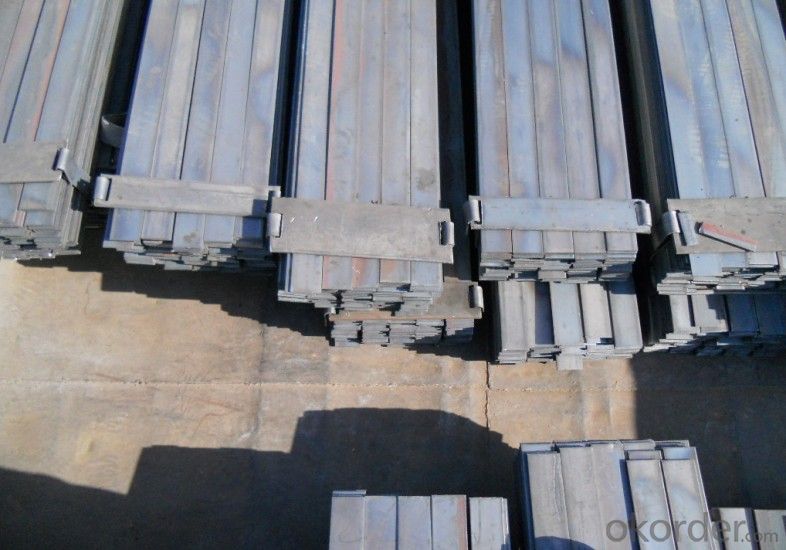
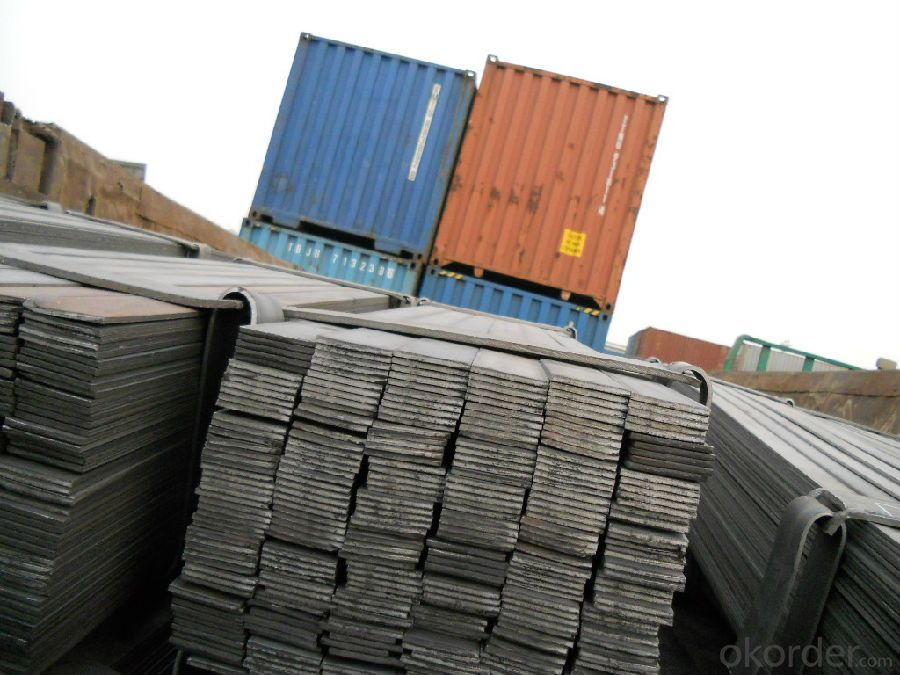
- Q:Can steel flat bars be bent or formed into different shapes?
- Yes, steel flat bars can be bent or formed into different shapes. Steel is a highly malleable material, which means it can be easily manipulated and shaped without breaking or cracking. Bending or forming steel flat bars can be achieved by using various methods such as heat bending, cold bending, or using specialized machinery like a press brake. The flexibility and versatility of steel make it a popular choice for construction, manufacturing, and various other industries where customized shapes and structures are required.
- Q:What are the standard dimensions of steel flat bars?
- The standard dimensions of steel flat bars vary depending on the specific requirements and standards set by different industries and manufacturers. However, common standard dimensions for steel flat bars include widths ranging from 1/8 inch to 12 inches and thicknesses from 3/16 inch to 1 inch. The length of steel flat bars is typically in the range of 20 feet, but can also be customized to meet specific project needs.
- Q:How do steel flat bars compare to carbon fiber flat bars?
- There are distinct differences between steel flat bars and carbon fiber flat bars in terms of their material composition, strength, weight, and applications. Steel flat bars, made from various grades of steel, possess exceptional strength and durability. They exhibit high resistance to bending, breaking, and deformation, making them suitable for heavy-duty purposes like construction, manufacturing, and structural support. Moreover, steel flat bars are easily accessible and cost-effective compared to carbon fiber flat bars. On the contrary, carbon fiber flat bars consist of carbon fibers embedded in a polymer matrix. This combination creates an incredibly lightweight and robust material. Carbon fiber flat bars have a remarkable strength-to-weight ratio, making them perfect for applications where reducing weight is crucial, such as aerospace, automotive, and sports equipment. Furthermore, they display excellent resistance to corrosion and fatigue, ensuring longevity even in harsh environments. While steel flat bars offer superior strength and affordability, carbon fiber flat bars excel in weight reduction and specific applications that require lightweight and high-strength materials. The choice between the two depends on the specific requirements of the project or application.
- Q:Are steel flat bars suitable for fabrication of frames or structures?
- Yes, steel flat bars are commonly used in the fabrication of frames or structures due to their high strength, durability, and versatility. They provide excellent support and stability, making them suitable for various applications in construction, manufacturing, and engineering industries.
- Q:How is a steel flat bar made?
- A steel flat bar is made through a process called hot rolling. It begins with a heated slab of steel that is passed through a series of rollers, which gradually shape and flatten it into the desired flat shape. The hot rolling process helps to improve the strength and durability of the steel, making it suitable for various applications in construction, manufacturing, and other industries.
- Q:Do I need to make the ring galvanized flat steel ground connection between the electric well and the distribution room?
- There is also a dark, in the foundation of the house to consider the distribution of indoor total potential imbalance, in the basic reinforcement welding has been laid. Later, when installing the equipment, just connect in place
- Q:How do steel flat bars perform in high-vibration environments?
- Steel flat bars are known for their exceptional strength and durability, making them suitable for a wide range of applications. However, when it comes to high-vibration environments, their performance can be affected. In high-vibration environments, steel flat bars are prone to fatigue failure due to the repeated stress cycles caused by the vibrations. This can lead to cracking or even complete failure of the bars over time. To mitigate these issues, there are several measures that can be taken. The first is to select a steel alloy that has high resistance to fatigue and can withstand the vibration levels expected in the environment. Additionally, the design of the structure or system should take into account the potential for vibrations, ensuring that the flat bars are properly supported and reinforced to minimize stress concentrations. Furthermore, proper installation and maintenance are crucial to ensuring the performance of steel flat bars in high-vibration environments. Regular inspections should be conducted to identify any signs of fatigue or damage, and necessary repairs or replacements should be carried out promptly. In summary, while steel flat bars offer excellent strength and durability, their performance in high-vibration environments can be compromised. By selecting the right steel alloy, designing structures to minimize stress concentrations, and implementing proper installation and maintenance practices, the performance of steel flat bars in such environments can be enhanced.
- Q:Can steel flat bars be used in the manufacturing of playground equipment?
- Yes, steel flat bars can be used in the manufacturing of playground equipment. Steel is a strong and durable material that is often used in construction and manufacturing due to its ability to withstand heavy loads and resist corrosion. Steel flat bars can be used to create sturdy frames, supports, and structural components in playground equipment, ensuring the safety and longevity of the equipment.
- Q:Can steel flat bars be used for making packaging machinery or equipment?
- Yes, steel flat bars can be used for making packaging machinery or equipment. Steel is a strong and durable material that can withstand the heavy loads and high speeds typically required in packaging machinery. Steel flat bars can be easily shaped and welded to create the necessary components and structures for packaging equipment. Additionally, steel has excellent resistance to corrosion, making it suitable for use in packaging machinery where it may be exposed to moisture or harsh environments. Overall, steel flat bars are a versatile and reliable choice for manufacturing packaging machinery or equipment.
- Q:What are the common tolerances for steel flat bars?
- The common tolerances for steel flat bars can vary depending on the specific requirements and standards set by the industry or customer. However, there are generally accepted tolerances that are widely used in the manufacturing and construction sectors. In terms of thickness, the common tolerance for steel flat bars is typically ± 0.005 inches or ± 0.13 millimeters. This means that the actual thickness of the flat bar can deviate by up to 0.005 inches or 0.13 millimeters from the specified thickness. For width, the common tolerance is usually ± 0.020 inches or ± 0.5 millimeters. This means that the actual width of the flat bar can vary by up to 0.020 inches or 0.5 millimeters from the specified width. In terms of length, the common tolerance is typically ± 0.125 inches or ± 3 millimeters. This means that the actual length of the flat bar can deviate by up to 0.125 inches or 3 millimeters from the specified length. It is important to note that these common tolerances may vary depending on the specific application, industry standards, or customer requirements. Therefore, it is always advisable to consult the relevant standards or specifications to determine the precise tolerances for a particular steel flat bar.
1. Manufacturer Overview |
|
|---|---|
| Location | |
| Year Established | |
| Annual Output Value | |
| Main Markets | |
| Company Certifications | |
2. Manufacturer Certificates |
|
|---|---|
| a) Certification Name | |
| Range | |
| Reference | |
| Validity Period | |
3. Manufacturer Capability |
|
|---|---|
| a)Trade Capacity | |
| Nearest Port | |
| Export Percentage | |
| No.of Employees in Trade Department | |
| Language Spoken: | |
| b)Factory Information | |
| Factory Size: | |
| No. of Production Lines | |
| Contract Manufacturing | |
| Product Price Range | |
Send your message to us
Hot Rolled Flat Bars in Grade Q235B with Good price
- Loading Port:
- Tianjin
- Payment Terms:
- TT OR LC
- Min Order Qty:
- 25 m.t.
- Supply Capability:
- 10000 m.t./month
OKorder Service Pledge
OKorder Financial Service
Similar products
New products
Hot products
Related keywords
